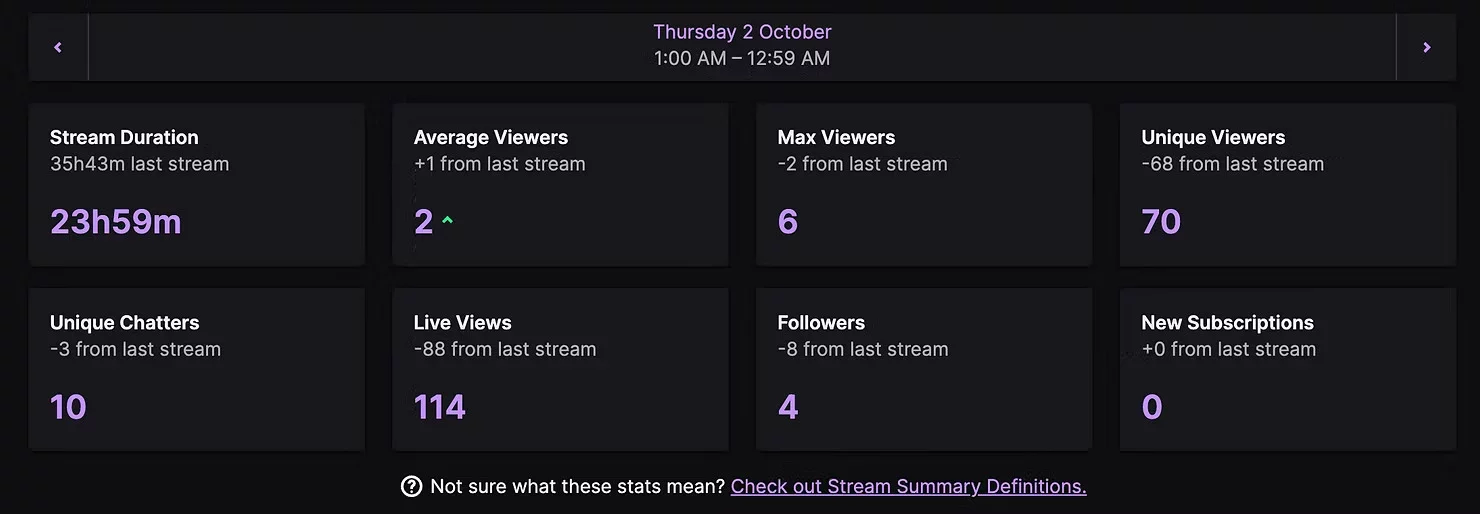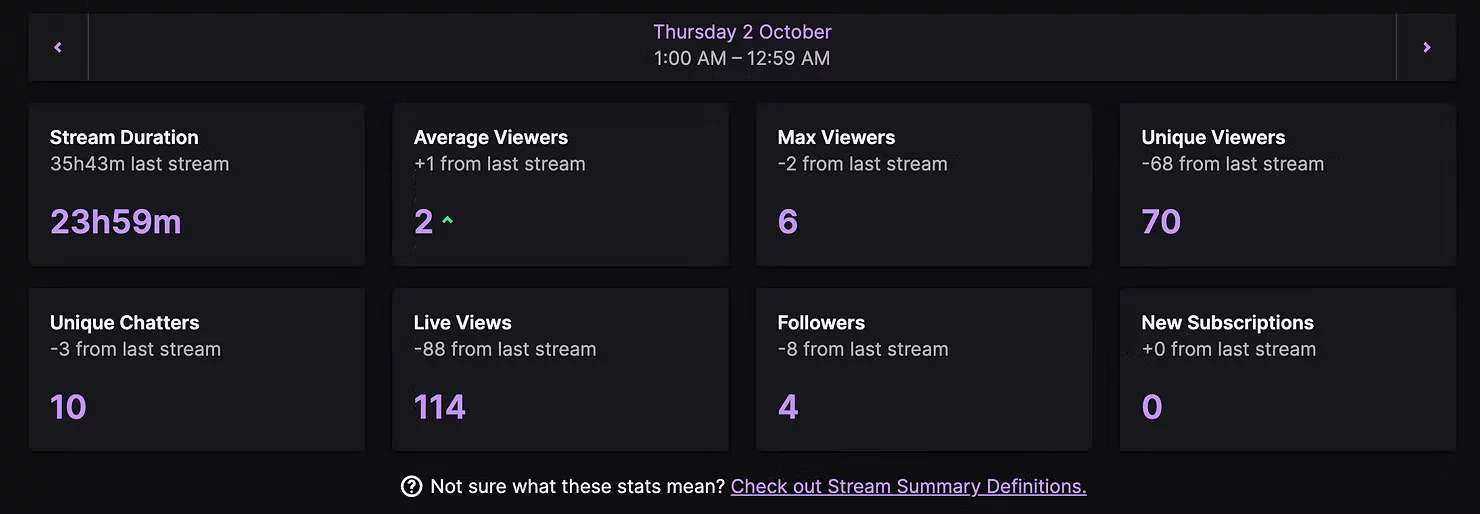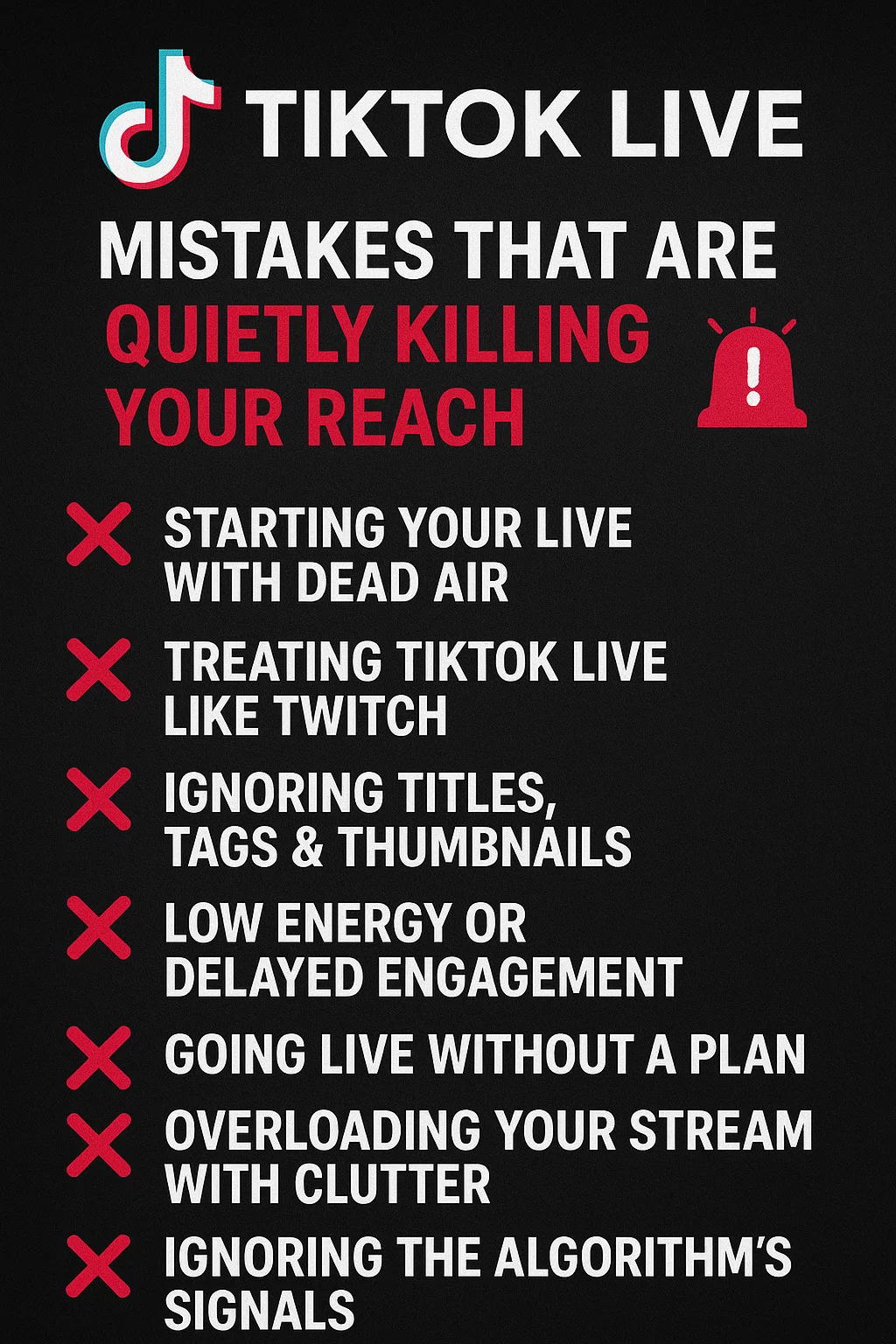Twitch Analytics Explained: What Actually Matters


Let’s be honest: Twitch analytics can feel like alphabet soup when you first see them. Average Viewers. Unique Viewers. Watch Time. Retention. It’s a lot, and if you’re like most streamers, you’ve probably opened the Creator Dashboard, stared at a bunch of numbers and then closed it again to go live.
Twitch analytics aren’t just vanity stats. If you know what to look for, they’re one of the best tools you have to actually grow your stream.
The trick is focusing on what actually matters, not every number under the sun.
Before we dive in, we actually chatted about this topic with Kings_crtduring a recent interview. Here’s a quick YouTube Short where we cover Twitch analytics to get you warmed up 👇
🎯 1. Average Viewers: Your Real “Core” Metric
This is the number Twitch cares about most when it comes to milestones like Affiliate and Partner. It's also the metrics used to sort streamers in a category when viewers are browsing Twitch. It’s also a solid indicator of your core community size.
Why it matters:
It shows how many people are consistently watching your stream at any given moment.
It smooths out spikes from raids or one-off surges, giving a realistic view of your typical audience.
It’s used in Twitch’s Partner requirements (75+ average viewers).
How to use it:
Track trends over time (week-to-week or month-to-month), not daily fluctuations.
Don’t obsess if it dips one day. Instead, look for patterns (e.g., certain games or time slots performing better).
Set small, realistic growth goals. For example, going from 5 → 8 average viewers consistently is a big deal.
Pro tip: Pair this with your scheduleconsistency. Average viewers almost always stabilize and grow when you stream at regular times.
👥 2. Unique Viewers: Reach vs. Retention
Unique Viewers tell you how many different people stopped by your stream during a broadcast.
Why it matters:
It shows your stream’s reach: how many eyeballs you attracted, even briefly.
High unique viewers with low average viewers usually means people are clicking in but not sticking around.
How to use it:
Compare Unique Viewers with Average Viewers. If you have 200 unique viewers but an average of 10, it means you got attention but didn’t keep it.
Re-watch your VODs and pay attention to the first 60 seconds, that’s usually where you win or lose people.
Improve your intro, overlays, or hooks to retain more of those unique viewers.
Pro tip: Watch what some streamers with a slightly higher viewership than yours do during their stream to retain their viewers to get inspired for your stream.
⏱ 3. Watch Time: The “Loyalty” Indicator
Watch Time (total hours watched) doesn’t get talked about enough. It’s basically how much time people are choosing to spend with you.
Why it matters:
High watch time signals strong viewer loyalty.
It influences how Twitch recommends your stream in categories and “Recommended For You” sections.
Sponsors and partners love this metric, it shows real engagement.
How to use it:
Focus on increasing session length per viewer by keeping streams engaging.
Encourage viewers to hang out longer (e.g., teasing upcoming segments, interacting with chat more).
Don’t obsess over total hours if you stream less frequently, look at average watch time per viewer if possible.
📈 4. Follower Growth: Momentum, Not the End Goal
Follower count can be a bit misleading. A sudden spike looks exciting, but followers don’t equal viewers. You can see streamers with thousands of followers with less than 5 viewers.
Why it matters:
It’s a good indicator of how well your content is attracting new people.
Steady growth usually reflects increased visibility through raids, social content, or category placement.
How to use it:
Focus on consistent growth, not viral spikes.
Compare follow spikes to what happened that day: did you get raided? Try a new game? Collaborate?
Encourage follows strategically (e.g., “If you’re enjoying the vibe, hit follow as we go live every Tuesday and Thursday!”), but don’t spam.
🌐 5. Chat Activity: The Hidden Gem Metric
One of the most underrated analytics on Twitch is chat activity. A chat with 10 active people can feel way more alive than a stream with 50 lurkers.
Why it matters:
It reflects community health and engagement more than almost any other number.
Active chats improve viewer retention: people stick around where conversation is happening.
Twitch notices engagement when recommending streams.
How to use it:
Track messages per minute or active chatters per stream.
Use AI chatbots like ai_licia to keep conversation flowing during slow moments
Encourage chat to talk to each other, not just you. That’s where community starts forming.
🔄 6. Retention Graphs: Where You’re Losing People
In your analytics dashboard, Twitch shows viewer retention graphs for each stream. These are gold.
Why it matters:
You can see exactly when viewers drop off.
It often reveals weak intros, boring mid-stream sections, or segments that drag on too long.
It also traduce viewer fatigue and after how long it tends to lead to drops.
How to use it:
Look at the first 5–10 minutes closely. If there’s a steep drop, tighten up your intro.
Identify boring segments and either improve or cut them.
Experiment with pacing and note how retention changes.
Even small tweaks to the first 2 minutes can make a massive difference in keeping new viewers around.
🛠 7. Bits, Subs & Revenue Metrics: Useful but Secondary
Money metrics are important, but they don’t tell the full growth story. If you are looking to become a full time creator, you may want to grow your average viewer count as it translates into a higher average revenue.
Why they matter:
They help track your income and reward loyal supporters.
Sudden dips might indicate changes in community behavior or schedule consistency.
How to use them wisely:
Track who is supporting regularly (loyal subs, gifters), these are your community MVPs.
Don’t use revenue spikes as your only success marker. Some of your best growth streams might not be your highest earning ones.
📝 What You Don’t Need to Obsess Over
There are a few metrics that are easy to get stuck on but don’t actually help you grow much on their own:
Peak viewers: Fun to see, but it’s often skewed by raids or short spikes.
Clip views: More useful for social media than Twitch growth itself.
Minutes streamed: Streaming more doesn’t automatically equal growth if quality isn’t there.
Host numbers: Largely outdated after Twitch phased out hosts.
These aren’t useless, just don’t let them drive your strategy.

🧠 Final Thoughts
Twitch gives you a lot of data, but real growth happens when you focus on the right signals:
Average Viewers = core community
Unique Viewers + Retention = how well you hook newcomers
Watch Time + Chat Activity = how loyal and engaged your viewers are
Follower Growth = momentum check
Retention Graphs = where to improve your content flow
Don’t drown in dashboards, pick a few metrics to track consistently, use them to make smart tweaks, and give changes time to work.
And remember, behind every number is a person choosing to spend their time with you. The data just helps you understand their behavior a little better.


